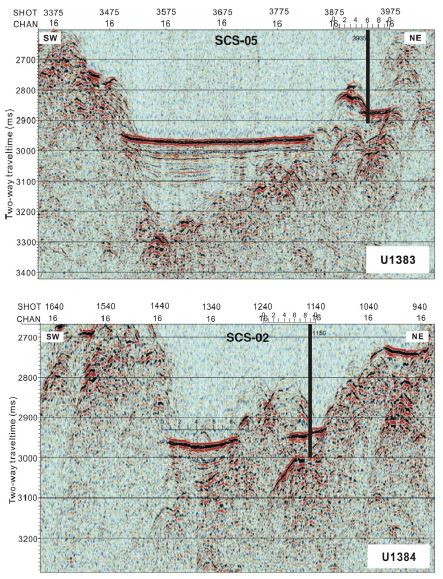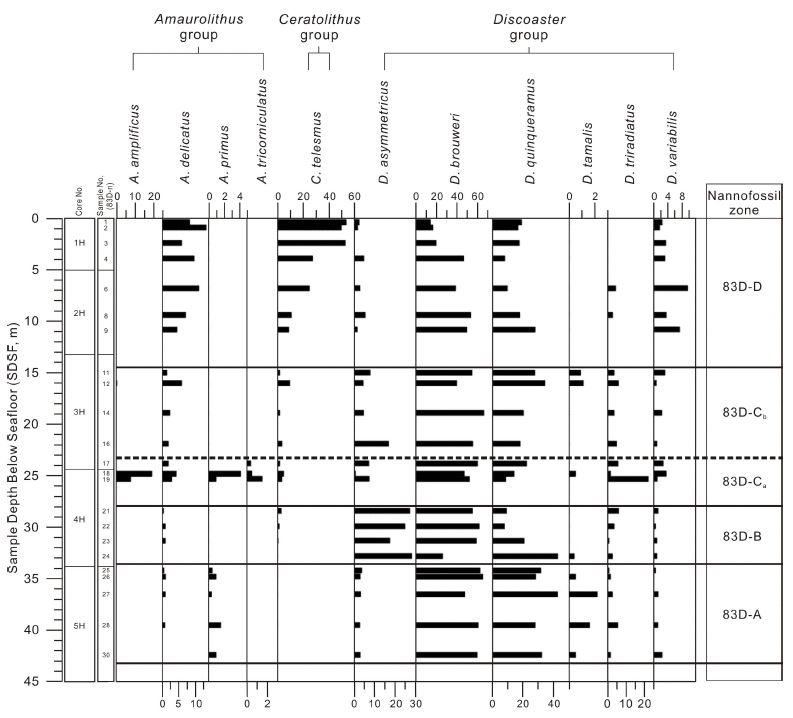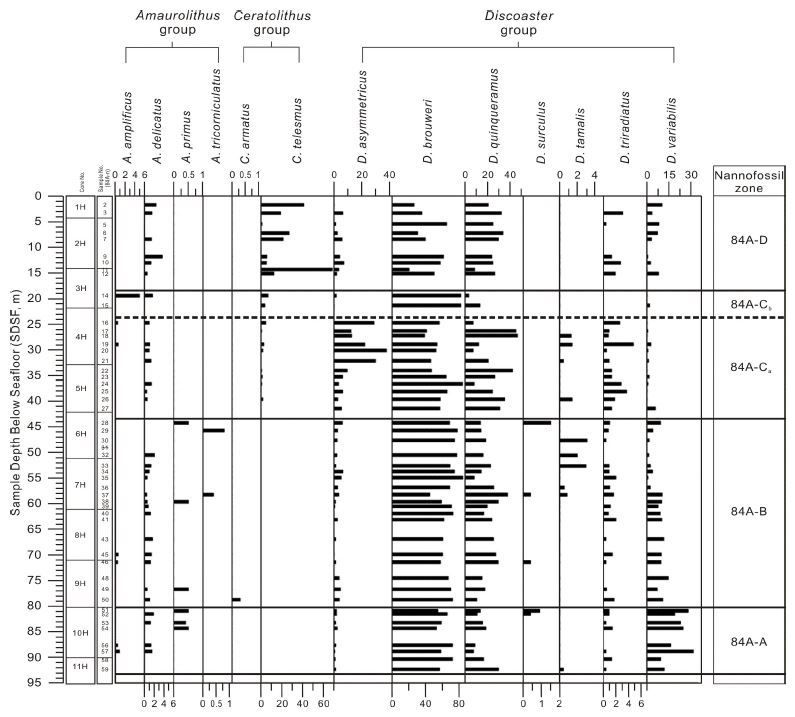
Calcareous nannofossil biostratigraphy of North Pond area, Mid-Atlantic Ridge and its paleoenvironmental implication
Calcareous nannofossils from two drill holes (U1383D and U1384A) at North Pond area, Mid-Atlantic Ridge by IODP Expedition 336 were analyzed to establish biostratigraphy and interpret paleoenvironment. According to results of calcareous nannofossil analysis, 11 species of three genera were identified in U1383D and four biozones are recognized; they are, in ascending order, 83D-A (Amaurolithus tricorniculatus zone/NN12-NN14 zone), 83D-B (Reticulofenestra pseudoumbilica zone/NN15-NN16 zone), 83D-C (Discoaster brouweri zone/NN17-NN18 zone), and 83D-D (after NN18 zone). The drilled section of Hole U1383D is considered to have been deposited during the late-Late Miocene to the Pleistocene, and the oldest age to be approximately 5.6 Ma. In U1384A, 13 species of three genera were identified and four biozones are recognized; they are, in ascending order, 84A-A (Amaurolithus primus subzone/NN11B zone), 84A-B (Amaurolithus tricorniculatus zone/NN12-NN14 zone), 84A-C (Reticulofenestra pseudoumbilica zone, Discoaster brouweri zone/NN15-NN18 zone), and 84A-D (after NN18 zone). The age of U1384A ranges from the Late Miocene to the Pleistocene, and the oldest age is considered to be approximately 7.2 Ma. The North Pond area is interpreted to have been influenced by warm water and in stratified and oligotrophic conditions from the Late Miocene to the Middle Pliocene. Afterward, transitional environment under weakening warm water influence prevailed during the Late Pliocene-Middle Pleistocene. In the Late Pleistocene, the area is considered to be effected by relatively cold water and in eutrophic environment.
초록
중부대서양해령 North Pond에서 IODP Expedition 336이 시추한 U1383D와 U1384A 코어퇴적물로부터 산출된 석회질 초미화석을 분석하여 생층서 분대를 설정하고 고환경을 해석하였다. 석회질 초미화석 분석 결과, Hole U1383D에서는 3속 11종의 석회질 초미화석이 산출되었으며, 하부로부터 83D-A (Amaurolithus tricorniculatus zone/NN12-NN14), 83D-B (Reticulofenestra pseudoumbilica zone/NN15-NN16 zone), 83D-C (Discoaster brouweri zone/NN17-NN18 zone), 83D-D (NN18 zone 이후)에 대비된다. 즉, Hole U1383D는 후기 마이오세 말부터 플라이스토세까지 퇴적되었고, 가장 오랜 퇴적시기는 약 5.6 Ma로 추정된다. Hole U1384A에서는 3속 13종의 석회질 초미화석이 산출되었으며, 하부로부터 84A-A (Amaurolithus primus subzone/NN11B zone), 84A-B (Amaurolithus tricorniculatus zone/NN12-NN14 zone), 84A-C (Reticulofenestra pseudoumbilica zone, Discoaster brouweri zone/NN15-NN18 zone), 84A-D (NN18 zone 이후)로 분대되었다. 즉, Hole U1384A는 후기 마이오세부터 플라이스토세까지 퇴적되었고, 가장 오랜 퇴적시기는 약 7.2 Ma로 추정된다. 연구지역은 후기 마이오세-중기 플라이오세 동안 온난수괴의 영향이 우세하였고, 수괴가 성층화된 빈영양 환경이었던 것으로 보인다. 후기 플라이오세-중기 플라이스토세 동안에는 온난수괴의 영향이 점차 약해지는 전이 환경이었던 것으로 해석된다. 후기 플라이스토세에는 수온이 상대적으로 매우 낮고, 부영양 환경이었던 것으로 추정된다.
Keywords:
Calcareous nannofossil, Discoaster, Biostratigraphy, Paleoenvironment, IODP Expedition 336, 석회질 초미화석, 생층서분대, 고환경1. 서 론
IODP (Integrated Ocean Drilling Program) Expedition 336은 심해저 미생물 군집을 연구하기 위하여 중부대서양해령에 위치한 North Pond에서 시추탐사를 수행하였으며, 이번 연구는 그 일환으로 수행하게 되었다.
석회질 초미화석은 중생대부터 해양에 널리 분포하였으며, 퇴적시기 결정 및 고환경 복원에 유용하게 이용된다(Farida et al., 2012). 특히 연구지역에서 가장 풍부하게 산출된 Discoaster는 신생대 신제3기(Neogene)의 석회질 초미화석으로 약 1.89 Ma에 멸종한 종이다(Backman and Shackleteon, 1983; Chepstow-Lusty et al., 1989, 1991). 이들은 또한 열대-아열대 환경을 지시하고 생산력이 낮으며 영양분이 적은 환경을 대표하는 종이기 때문에 퇴적시기 및 고환경을 추정하는데 유용하다(Backman and Shackleton, 1983; Driever, 1988; Chepstow-Lusty et al., 1989, 1991; Rio et al., 1990; Dmitrenko, 2004).
North Pond의 일부 지역은 DSDP (Hole 395)와 ODP (Hole 1074A)에 의해 이전에 시추된 곳이다. 이 North Pond 지역의 퇴적학, 광물학, 지화학적 특성 및 생층서 등은 이미 연구된 바 있다(Bukry, 1979; Krasheninnikov, 1979; Melson et al., 1979; Shipboard Scientific Party, 1979; Timofeev et al., 1979). 특히 생층서 연구에서 Bukry (1979)는 초미화석을 이용하여 Hole 395에서 가장 오래된 퇴적물이 Amaurolithus primus subzone에 속하고, 퇴적시기가 약 6.1(+ 1.6/- 1.2) Ma임을 밝혔다. Krasheninnicov (1979)는 부유성 유공충을 이용하여 Hole 395의 퇴적물을 7개의 층서 단위로 나누었으며 기저 퇴적물의 퇴적시기를 후기 마이오세-초기 플라이오세라고 보고하였다.
North Pond 지역은 불규칙한 경사가 있고 기복이 나타나는 불안정한 지역이기 때문에 이 지역에 퇴적된 퇴적물은 저탁류의 영향을 받아 교란되거나, 시추 과정 동안 유입된 퇴적물이 혼합되어 있는 문제점이 있다(Bukry, 1979). 이러한 이유로 지금까지 이 지역에 대한 정확한 생층서 및 고환경 연구가 부족한 상황이다. 그러므로 North Pond 지역의 생층서 및 고환경 연구가 요구되며 이는 Expedition 336이 앞으로 수행할 연구에 중요한 기본 정보를 제공하게 될 것이다. 따라서 이 연구의 목적은 두 개의 시추 퇴적물 U1383D와 U1384A로부터 산출된 석회질 초미화석을 이용하여 생층서 분대를 설정하고 퇴적시기를 유추하며 당시 퇴적환경을 복원하는 것이다.
2. 연구지역
중부대서양해령(Mid-Atlantic Ridge)의 North Pond (22˚46'N, 46˚05'W)는 해령의 축에서 서쪽으로 약 140 km 떨어진 곳에 위치한 타원형의 넓은 분지(8 km × 15 km)이다(van Andel and Komar, 1969; Schmidt-Schierhorn et al., 2012; 그림 1). North Pond는 북동-남서 방향의 고립된 지역이고, 최대 높이가 약 2 km 정도 솟아있는 기반암에 의해 동쪽과 서쪽이 구분되어 있다(Expedition 336 Scientists, 2012a). 이 지역은 함몰지형들로 이루어져 있으며 이들을 경계 짓는 부분의 경사는 5-15°로 불규칙하고, 해저면은 5-10 m의 지역적 기복을 보인다(van Andel and Komar, 1969). North Pond는 측면의 가파른 경사에 의해 대량의 퇴적물이 공급되며, 이는 퇴적물 코어시료의 저탁류 구조를 통해 확인된다(Hussong et al., 1979; Schmidt- Schierhorn et al., 2012). 연구지역의 수심은 4,414- 4,483 m이고 4,500 m인 탄산염 보상심도(Carbonate Compensation Depth)보다 얕다(Ferdelman et al., 2009; Expedition 336 Scientists, 2012a). 퇴적물은 현무암질 지각의 상부를 덮고 있으며 분지의 최남단에서 최대 두께 300 m에 이른다(Picard and Ferdelman, 2011; Expedition 336 Scientists, 2012a). 이 지역의 정상자기는 Magnetic anomaly 4로 해석되고 이는 기반암의 연령이 7.43-8.07 Ma라는 것을 지시한다(Purdy et al., 1979; Expedition 336 Scientists, 2012a).
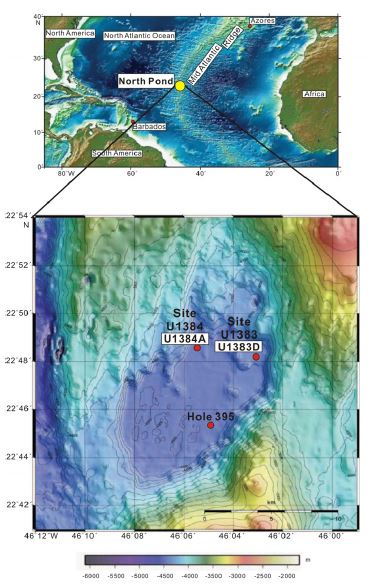
Location map and bathymetric map of North Pond showing locations of Sites U1383, U1384 and Hole 395 (modified from Expedition 336 Scientists, 2012a).
Site U1383은 North Pond의 북동쪽에 위치하고, 퇴적물 두께는 38-51 m의 범위로 나타난다(Expedition 336 Scientists, 2012a; 그림 1). 연구 코어퇴적물 Hole U1383D (22˚48.13'N, 46˚03.10'W; 수심: 4,413.8 m)는 44.3 m의 퇴적물과 1 m의 현무암 및 석회암으로 교결된(limestone-cemented) 각력암이 분포한다. Hole U1383D의 퇴적물은 시추 시, 일부 시료에서 약간의 교란(minimal disturbance)이 발생하였다고 보고되었다(Expedition 336 Scientists, 2012b). Site U1384는 North Pond의 북서쪽에 위치하고, Site U1383으로부터 서쪽으로 약 3.9 km 떨어진 곳에 위치해 있다(그림 1). Site U1384의 퇴적물 두께는 최대 90 m에 이르며, Hole U1384A (22˚48.71'N, 46˚05.35'W; 수심: 4,464 m)는 93.5 m의 퇴적물과 0.58 m의 현무암 및 석회암으로 교결된 각력암이 분포한다(Expedition 336 Scientists, 2012a, 2012b). Hole U1384A의 퇴적물은 일부 구간을 제외하면 시추 중 거의 교란되지 않았다고 보고되었다(Expedition 336 Scientists, 2012b). Hole U1383D와 Hole U1384A 모두 탄성파 탐사자료를 통하여 경사진 해령(ridge) 근처에 위치함을 알 수 있다(그림 2).
3. 시료 및 방법
연구 코어퇴적물 Hole U1383D와 Hole U1384A는 주로 석회질 초미화석 연니와 유공충을 포함한 사질층으로 구성되어 있다. 암상은 크게 5가지: foraminifer-bearing nannofossil-rich ooze, nannofossil-bearing foraminifer-rich ooze, foraminifer & nannofossil rich ooze, nannofossil-rich ooze, foraminifer-rich ooze로 나누어진다(Expedition 336 Scientists, 2012a). Hole U1383D의 퇴적물의 경우, 5 가지의 암상이 모두 나타나지만 Hole U1384A에서는 foraminifer-bearing nannofossil ooze, nannofossil-bearing foraminifer-rich ooze와 nannofossil-rich ooze만이 나타난다(그림 3a-b).
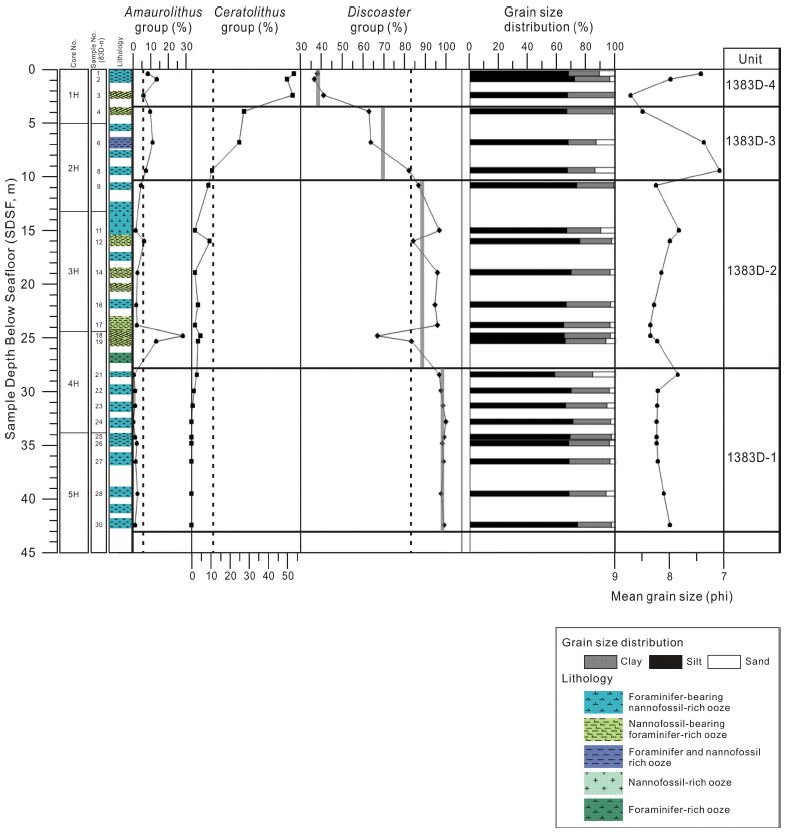
Occurrence of three nannofossil groups and the result of grain size analysis with depth in Hole U1383D. Vertical dotted lines indicate mean occurrence. Grey solid lines indicate the mean percentage of Discoaster occurrence.

Occurrence of three nannofossil groups and the result of grain size analysis with depth in Hole U1384A. Vertical dotted lines indicate mean occurrence. Grey solid lines indicate the mean percentage of Discoaster occurrence.
Hole U1383D와 Hole U1384A에서 약 1 m 간격으로 총 89개의 퇴적물 시료(U1383D: 30개, U1384A: 59개)를 채취하였다. 이 중 연구지역에서 발생한 저탁류와 시추 작업에 의해 교란의 영향을 심하게 받은 것으로 인지되는 시료는 제외하고, 총 73개의 시료(U1383D: 23개, U1384A: 50개)를 분석하였다. 시추 중 교란의 영향을 받은 시료는 Expedition 336 Scientists (2012b)의 보고서를 참고하여 제외하였다(83D-7, 29/84A-55번 시료). 저탁류 영향을 받은 시료는 유공충을 포함한 사질층으로 알려져 있기 때문에(Kuenen and Menard, 1952; Krasheninnikov, 1979; Melson et al., 1979) 입도분석을 통하여 제거하였다(83D-5, 10, 13, 15, 20/84A-1, 4, 8, 13, 31, 42, 44, 47번 시료). 입도 분석은 한국지질자원연구원이 보유하고 있는 S3500 Particle Size Analyzer (Microtrac Inc.)를 사용하였으며, 연구지역의 퇴적물은 탄산염 함량이 높은 생물기원 퇴적물로서(Expedition 336 Scientists, 2012a), 이를 제거할 경우 퇴적학적으로 유용한 정보 역시 사라질 가능성이 있기 때문에 전처리를 하지 않았다(Pilkey, 1964). 분석 후 GRADISTAT 프로그램으로 통계처리를 하였고, 평균 입도(mean grain size)와 모래(sand), 실트(silt), 점토(clay)의 상대적 함량을 결과에 나타냈다(Folk and Ward, 1957; Blott and Pye, 2001).
교란의 영향을 제외한 모든 시료는 미화석의 종과 산출빈도를 파악하기 위해 smear slide를 제작하여 편광현미경(DM 2500P, Leica)을 통해 ×1000 배율로 관찰되었다. 미화석이 적게 존재하는 일부 시료를 제외한 모든 시료에서 총 200개체(specimen)를 확인하였다. 미화석의 종을 파악한 후 전체 미화석 종에 대한 지시종의 수를 상대적으로 나타내어 산출빈도를 표현하였다(e.g., Rio et al., 1990). 이 연구에서 확인된 미화석은 대부분 Discoasteraceae 과(Family)와 Ceratolithaceae 과(Family)에 속하는 종들로 중요한 지시종으로 사용되었다(그림 4a-b).
4. 결 과
4.1 입도분석
퇴적물의 입도분석 결과, Hole U1383D의 평균 입도는 8.7-7.1 Φ (2.4-7.4 μm)의 범위로 나타났다(그림 3a). 대부분의 시료는 극세립 실트(very fine silt)-세립 실트(fine silt)로 분류되었다. 모래, 실트, 점토의 평균 함량은 각각 5.5%, 68.1%, 26.4%로 나타났고, 이를 통하여 Hole U1383D의 퇴적물은 주로 실트로 구성되어 있음을 알 수 있다. Hole U1384A의 평균 입도는 8.6-7.5 Φ (2.6-5.8 μm)의 범위로 나타났다(그림 3b). 대부분의 시료는 극세립 실트-세립 실트로 분류되었다. 모래, 실트, 점토의 평균 함량은 각각 3.3%, 72.3%, 24.4%이고, 따라서 Hole U1384A의 퇴적물도 주로 실트로 구성된다
4.2 석회질 초미화석 분석
North Pond 퇴적물에서는 주로 신제3기-제4기의 중요한 종들이 산출되었다. 이들은 대부분 Discoasteraceae 과(Family)의 Discoaster 속(Genus), 그리고 Ceratolithaceae 과의 Amaurolithus 속 및 Ceratolithus 속에 포함되는 종들이다. 그 중 가장 풍부한 종은 Discoaster brouweri이고, 그 뒤로 D. quinqueramus와 Ceratolithus telesmus들이 일반적으로 산출되었다.
Hole U1383D 퇴적물에서는 3속 11종의 석회질 초미화석이 산출되었다(그림 4a). Hole U1383D의 석회질 초미화석의 종조성은 D. brouweri, D. quinqueramus 및 C. telesmus 등의 주요 산출종과 D. asymmetricus, D. tamalis, D. triradiatus, D. variabilis, A. amplificus, A. delicatus, A. primus 및 A. tricorniculatus와 같은 소수종으로 산출된다.
각 산출종들을 속 별로 그룹화(Amaurolithus·Ceratolithus·Discoaster)하여 깊이에 따른 산출빈도를 입도분석 결과와 함께 나타내었다(그림 3a). Amaurolithus 그룹은 A. amplificus, A. delicatus, A. primus와 A. tricorniculatus를 포함한다. 이 그룹은 0-28.2%(평균 5.4%)의 산출빈도 범위를 보인다. Ceratolithus 그룹은 C. telesmus만을 포함하고, 산출빈도는 0-53.6%(평균 11.3%)이다. Discoaster 그룹은 D. asymmetricus, D. brouweri, D. quinqueramus, D. tamalis와 D. variabilis를 포함한다. 이 그룹의 산출빈도는 36.8-100%(평균 83.3%)이다. Amaurolithus 그룹은 일부 구간을 제외하고 Ceratolithus 그룹과 산출빈도 양상이 동일하게 나타났다. Discoaster 그룹은 일부 구간을 제외하고 두 그룹과 산출빈도가 반대인 특징이 보인다.
Hole U1383D는 깊이에 따른 초미화석 그룹의 산출빈도 및 입도 변화를 통하여 네 구간(Unit 1383D-1, 1383D-2, 1383D-3, 1383D-4)으로 나누어진다(그림 3a). Unit 1383D-1은 시추공의 하부(SDSF 28.4-42.4 m)에 해당하고 세 그룹의 산출빈도 및 입도 변화는 거의 없는 것으로 관찰된다. 이 구간에서 Amaurolithus 그룹과 Ceratolithus 그룹의 평균 산출빈도는 각각 1.1%, 0.5%로 매우 저조하지만 Discoaster 그룹의 평균 산출빈도는 98.4%에 이른다. Unit 1383D-2는 시추공의 중부(SDSF 10.8-25.3 m)에 해당하고 세 그룹의 산출빈도와 입도의 변화가 나타나기 시작하는 것이 특징이다. Amaurolithus 그룹의 평균 산출빈도는 약 7.5%, Ceratolithus 그룹은 4.4%, Discoaster 그룹은 약 88.1%이다. Unit 1383D-1의 평균 산출빈도와 비교하였을 때 Amaurolithus 그룹과 Ceratolithus 그룹은 증가하는 반면, Discoaster 그룹은 감소하는 양상을 보여준다. Unit 1383D-3은 시추공의 상부(SDSF 3.9-9.4 m)에 해당하고 세 그룹의 산출빈도와 입도의 변화 폭이 U1383D-2보다 크다. 또한 Amaurolithus 그룹과 Ceratolithus 그룹의 산출빈도는 평균 이상으로, Discoaster 그룹은 평균 이하로 감소하는 구간이다. 이 구간에서 Amaurolithus 그룹, Ceratolithus 그룹, Discoaster 그룹의 평균 산출빈도는 각각 9.3%, 21%, 69.7%이다. Unit 1383D-4는 시추공의 최상부(SDSF 0.4-2.4 m)에 해당하고 세 그룹의 산출빈도 및 입도 변화의 폭이 좁다. 특히 이 구간은 Ceratolithus 그룹의 최대 산출과 Discoaster 그룹의 최소 산출이 그 특징이다. Unit 1383D-4에서 Amaurolithus 그룹, Ceratolithus 그룹, Discoaster 그룹의 평균 산출빈도는 각각 9.2%, 52.2%, 38.7%이다.
Hole U1384A 퇴적물에서는 3속 13종의 석회질 초미화석이 산출되었다(그림 4b). Hole U1384A의 석회질 초미화석의 종조성은 D. brouweri, D. quinqueramus, D. variabilis 및 C. telesmus 등의 주요 산출종과 D. asymmetricus, D. surculus, D. tamalis, D. triradiatus, A. amplificus, A. delicatus, A. primus, A. tricorniculatus 및 C. armatus와 같은 소수종으로 구성된다.
각 산출종들을 속별로 그룹화(Amaurolithus·Ceratolithus·Discoaster)하여 깊이에 따른 산출빈도를 입도분석 결과와 함께 나타내었다(그림 3b). Amaurolithus 그룹은 A. amplificus, A. delicatus, A. primus와 A. tricorniculatus를 포함하고, 0-6.5%(평균 1%)의 산출빈도 범위를 나타냈다. Ceratolithus 그룹은 C. armatus와 C. telesmus를 포함하고 0-68.3%(평균 4.3%)의 넓은 산출빈도 범위를 보인다. Discoaster 그룹은 D. asymmetricus, D. brouweri, D. quinqueramus, D. surculus, D. tamalis와 D. variabilis를 포함하고, 산출빈도 범위는 31.6-100%(평균 94.6%)이다. Amaurolithus 그룹은 거의 모든 구간에서 Ceratolithus 그룹과 비례적이었고, Discoaster 그룹은 나머지 두 그룹과 산출빈도 양상이 반대로 나타났다.
Hole U1384A는 깊이에 따른 초미화석 그룹의 산출빈도 및 입도 변화를 통하여 세 구간(Unit 1384A-1, 1384A-2, 1384A-3)으로 나누어진다(그림 3b). Unit 1384A-1은 시추공의 중-하부(SDSF 30.2-92.4 m)에 해당하고 초미화석 산출빈도의 변화가 작거나 없으며 입도 또한 일부 시료를 제외하면 변화가 거의 없다. Unit 1384A-1에서 Amaurolithus 그룹과 Ceratolithus 그룹의 평균 산출빈도는 1% 미만인 반면, Discoaster 그룹의 평균 산출빈도는 99%에 이른다. Unit 1384A-2는 시추공의 상부(SDSF 7.3-29 m)에 해당하고 세 그룹의 산출빈도와 입도 변화가 나타나기 시작한다. 세 그룹의 평균 산출빈도는 각각 Amaurolithus 그룹은 1.3%, Ceratolithus 그룹은 13%, Discoaster 그룹은 85.6%이다. Unit 1384A-1의 평균 산출빈도와 비교하였을 때 Amaurolithus 그룹과 Ceratolithus 그룹은 증가하였고, Discoaster 그룹은 감소하였다. Unit 1384A-3은 시추공의 최상부(SDSF 1.8-5.5 m)에 해당하고 Amaurolithus 그룹과 Ceratolithus 그룹의 산출은 최상부로 갈수록 증가하는 반면, Discoaster 그룹의 산출은 감소하며 입도는 증가한다. Unit 1384A-3에서 Amaurolithus 그룹, Ceratolithus 그룹, Discoaster 그룹의 평균 산출빈도는 각각 1.3%, 20.1%, 78.7%이다.
5. 토 의
5.1 초미화석 분대 및 퇴적시기
Hole U1383D와 Hole U1384A에서 산출된 석회질 초미화석 중, 특정 종들의 뚜렷한 산출빈도 변화에 따라 생층서 분대를 결정하고 이를 표준 생층서 분대(Martini, 1971; Bukry, 1978; Young, 1999)와 대비하여 각 구간의 퇴적시기를 추정하였다(그림 4a-b, 5; 표 1). 두 시추공의 퇴적시기 설정에 대한 논의는 시추공의 하부에서 상부구간 순으로 아래와 같이 기술하였다. 아래에 사용된 약자 중 FO는 ‘First Occurrence’, FCO는 ‘First Common Occurrence’, LO는 ‘Last Occurrence’를 의미한다.
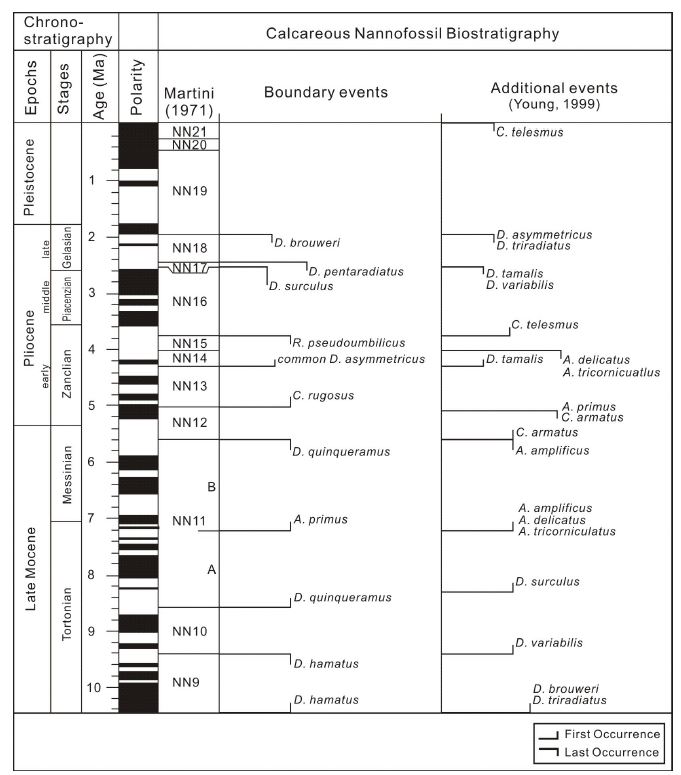
Chronostratigraphy and calcareous nannofossil biostratigraphy adopted in this study (modified from Martini, 1971 and Young, 1999).

Neogene nannofossil zonation of Holes U1383D, U1384A and DSDP Hole 395 (modified from Bukry, 1979 and Shipboard Scientific Party, 1979).
Hole U1383D에서는 4개의 생층서 분대(83D-A, 83D-B, 83D-C, 83D-D)가 설정되었다(그림 4a).
83D-A 분대(SDSF 34.2-42.4 m)는 D. brouweri (59.5 %)와 D. quinqueramus (32.4%)가 대부분을 차지하며 그 외에 D. asymmetricus (3%), D. triradiatus (1.5%), D. variabilis (1.1%)와 A. primus (0.9%) 등이 소량으로 산출된다. 이 중 D. quinqueramus는 후기 마이오세(NN11 zone)를 지시하는 종으로 D. quinqueramus의 마지막 출현(LO)은 마이오세와 플라이오세의 경계를 나누는데 사용된다(Marino and Flores, 2002). 또한 D. quinqueramus는 연구지역에서 교란과 상관없이 기저 퇴적물의 가장 오랜 퇴적시기를 알려주는 지시종으로 보고된 바 있다(Bukry, 1979). 하지만 이 연구에서 D. quinqueramus는 전 구간에서 높은 점유율로 산출되기 때문에 생층서를 구분하는데 부적절하고, 재동(reworked)된 것이라 판단하여 가장 오랜 퇴적시기 결정에만 참고하고 생층서 해석에서는 제외하였다. 산출되는 초미화석 중 A. primus (NN11B-NN12 zone)는 이 구간과 약 25 m의 심도에서 출현한다. 하지만 약 25 m에서 산출되는 A. primus는 재동된 것이라 판단하며 이에 대한 내용은 뒤에 언급되어 있다. 따라서 이 구간에서 A. primus가 마지막으로 출현하였다고 판단하기 때문에 Bukry (1978) 분대의 Amaurolithus tricorniculatus zone에 해당된다고 할 수 있다. 또한 C. telesmus (NN16-NN21 zone)가 산출되지 않았기 때문에 이 구간은 이 종이 처음 출현하는 3.6 Ma 이전에 퇴적되었을 것이다(그림 5). 따라서 종합적으로 해석하였을 때 83D-A 분대는 Bukry (1978)의 Amaurolithus tricorniculatus zone/Martini (1971)의 NN12-NN14 zone과 대비되며 퇴적시기는 후기 마이오세 말-초기 플라이오세(약 5.6-4 Ma)로 추정된다(표 1).
83D-B 분대(SDSF 28.4-32.8 m)에서는 D. asymmetricus가 83D-A 분대에 비해 급격히 증가하여 전체 초미화석 중 24.4%를 차지한다. D. brouweri (50.8%)는 83D-A 분대와 같이 풍부한 산출빈도를 보이고 그 외에 D. quinqueramus (20.1%)가 일반적으로 산출되며 D. triradiatus (2.1%)와 C. telesmus (1.2%) 등이 매우 소량으로 산출된다. D. asymmetricus는 플라이오세(NN14-NN18 zone, FCO: 4.3 Ma, LO: 1.93 Ma)를 지시하는 종이다(Stefano, 1998; 그림 5). D. asymmetricus의 최대산출(acme)은 Bukry (1978) 분대의 Reticulofenestra pseudoumbilica zone을 인지하는 기준이 된다. 또한 이 구간은 C. telesmus가 처음 출현하기 때문에 퇴적시기는 3.6 Ma 무렵인 것으로 판단된다. 따라서 이 분대는 Reticulofenestra pseudoumbilica zone/NN15-NN16 zone에 해당되며 초기 플라이오세-중기 플라이오세(약 4-2.6 Ma)에 퇴적되었다고 추정된다(표 1).
83D-C 분대(SDSF 15-25.3 m)는 83D-Ca (23.8-25.3 m)와 83D-Cb (15-21.9 m) 구간으로 나누어진다. 두 구간은 모두 83D-B 분대에 비해 D. asymmetricus (Ca: 5%, Cb: 8.4%)의 산출이 상당히 감소한다. 이 외에 D. brouweri (Ca: 53.4%, Cb: 54.4%)가 풍부하게 산출되고, D. quinqueramus (Ca: 15%, Cb: 25.1%), D. triradiatus (Ca: 6.2%, Cb: 2.9%)와 D. variabilis (Ca: 2.4%, Cb: 1.8%) 등이 출현한다. 하지만 83D-Ca 구간의 경우 다른 구간에 비해 A. amplificus (9%)와 A. primus (1.7%)의 산출빈도가 높게 나타나고, 이 구간에서만 유일하게 A. tricorniculatus가 출현한다. 이들은 모두 마이오세를 지시하는 종(A. amplificus: NN11B zone, A. primus: NN11B-NN12 zone, A. tricorniculatus: NN11B-NN14 zone)이기 때문에 재동된 것이라 판단된다(그림 5). 83D-Ca와 83D-Cb 구간은 재동된 종을 제외한 초미화석의 산출빈도 변화 양상이 유사하기 때문에 생층서 분대 및 퇴적시기가 같은 것으로 판단된다. 즉, 83D-C 분대는 D. brouweri가 풍부하고, D. triradiatus의 산출빈도가 다른 구간에 비해 높으며 D. tamalis가 마지막으로 출현하는 것이 특징이다. 따라서 이 분대는 Discoaster brouweri zone/NN17-NN18 zone과 대비되며 퇴적시기는 후기 플라이오세(약 2.6-2 Ma)로 추정된다(표 1).
83D-D 분대(SDSF 0.4-10.8 m)는 C. telesmus의 산출빈도가 급격히 증가하여 전체 초미화석의 32.6%를 차지한다. 반면 D. brouweri는 상당히 감소하여 34.3%의 평균 산출빈도를 보인다. 그 외에 D. quinqueramus (16.7%), D. variabilis (4.5%) 및 D. asymmetricus (2.7%)가 산출된다. C. telesmus는 NN16-NN21 zone에 포함되고 다른 종에 비해 젊은 시대를 지시한다(그림 5). 또한 D. brouweri의 감소는 이 종이 멸종하는 약 1.89 Ma 무렵임을 의미한다(Backman and Shackleteon, 1983; Chepstow-Lusty et al., 1989, 1991). 이 분대에서는 Bukry (1978) 분대를 분류하는 지시종이 산출되지 않아 Martini (1971) 분대만을 적용하였다. 따라서 83D-D 분대는 NN18 zone 이후부터 퇴적된 것으로 보이며 플라이스토세(약 2 Ma~)에 퇴적된 것으로 추정된다(표 1).
결과적으로 Hole U1383D의 퇴적층은 NN12-NN18 zone에 대비되고 후기 마이오세 말부터 플라이스토세까지 퇴적되었으며 가장 오랜 퇴적시기는 약 5.6 Ma로 판단된다.
Hole U1384A에서는 4개의 생층서 분대(84A-A, 84A-B, 84A-C, 84A-D)가 설정되었다(그림 4b).
84A-A 분대(SDSF 81-92.4 m)는 D. brouweri (61.2%)와 D. variabilis (20.4%)가 대부분을 차지하고 A. primus가 처음 출현하는 것이 특징이다. 이 외에 D. quinqueramus (15.1%)와 D. asymmetricus (1.3%) 등도 산출된다. A. primus의 처음 출현은 Bukry (1978) 분대의 Discoaster quinqueramus zone에 속하는 Amaurolithus primus subzone으로 분류하는 기준이 되며, 이는 후기 마이오세를 지시한다. 따라서 후기 마이오세에 드물게 산출되는 D. asymmetricus와 같은 신기 종들은 시추 중 교란에 의해 유입된 것으로 판단된다(Rio et al., 1990). 종합적인 해석에 의해 84A-A 분대는 Bukry (1978)의 Amaurolithus primus subzone/Martini (1971)의 NN11B zone에 해당되며 퇴적시기는 후기 마이오세(약 7.2-5.6 Ma)로 추정된다(표 1).
84A-B 분대(SDSF 44.3-78.8 m)에서는 D. brouweri (67.8%)가 계속 풍부하게 산출되고 D. quinqueramus (20.2%)도 상당수 출현한다. 또한 84A-A 분대와 비교하였을 때 D. variabilis (7%)의 산출은 상당히 감소하고, D. asymmetricus (2.6%)의 산출은 약간 증가하였다. 84A-B 분대에서 나타나는 A. primus와 A. tricorniculatus의 마지막 출현은 Amaurolithus tricorniculatus zone을 경계 짓는 기준이 된다(Bukry, 1978). 이 분대에서는 C. armatus가 유일하게 산출된 것이 특징이고(78.8 m) 이는 Martini (1971)의 NN12 zone에 속한다는 것을 의미한다(그림 5). 또한 C. telesmus가 산출되지 않았기 때문에 3.6 Ma 이전에 퇴적되었음을 알 수 있다. 따라서 84A-B 분대는 Amaurolithus tricorniculatus zone/NN12-NN14 zone에 대비되고 퇴적시기는 후기 마이오세 말-초기 플라이오세(약 5.6-4 Ma)로 추정된다(표 1).
84A-C 분대(SDSF 19.5-41.5 m)는 84A-Ca (24.8-41.5 m)와 83A-Cb (19.5-21.4 m) 구간으로 나누어진다. 84A-Ca 구간에서는 D. asymmetricus의 최대 산출빈도가 나타나며 이는 전체 초미화석 중 14.6%를 차지한다. 그 외에 D. brouweri (55.1%)가 풍부하게 산출되고 D. quinqueramus (25.4%)가 일반적으로 출현하며 D. triradiatus (1.9%)와 D. variabilis (1%)가 소량으로 산출된다. 84A-Cb 구간은 후기 마이오세를 지시하는 A. amplificus (NN11B zone)의 산출빈도가 다른 구간에 비해 높게 나타나는데 이들은 재동된 것이라 판단된다(그림 5). 84A-Ca와 84A-Cb 구간은 재동된 종을 제외한 초미화석의 산출빈도 변화 양상이 유사하기 때문에 생층서 분대 및 퇴적시기가 같은 것으로 추정된다. 84A-C 분대에서는 D. asymmetricus의 최대산출(acme)이 나타나고 D. tamalis가 마지막으로 출현한다. 또한 D. surculus가 더 이상 산출되지 않고 C. telesmus가 처음으로 출현한다. 이러한 특징들은 Bukry (1978) 분대 설정 특징과 유사하다고 판단된다. 따라서 84A-C 분대는 Reticulofenestra pseudoumbilica zone과 Discoaster brouweri zone/NN15-NN18 zone과 대비되고 퇴적시기는 초기 플라이오세-후기 플라이오세(약 4-2 Ma)로 추정된다(표 1).
84A-D 분대(SDSF 1.8-15.2 m)는 C. telesmus (22.1%)의 산출빈도가 급격하게 증가하는 반면, D. asymmetricus (3.5%)는 감소하는 특징을 보인다. 이 분대에서 D. brouweri (42.7%)는 다른 분대에 비해 상대적으로 낮은 산출빈도를 보인다. 이 외에 D. quinqueramus (24.9%)가 일반적으로 산출되고 D. variabilis (4.6%)와 A. delicatus (1.2%) 등이 출현한다. 이 구간에서는 Bukry (1978) 분대를 나누는데 필요한 종들이 산출되지 않아 Martini (1971) 분대만을 사용하였다. 즉, 84A-D 분대는 NN18 zone 이후부터 퇴적된 것으로 보이며 퇴적시기는 플라이스토세(약 2 Ma~)로 추정된다(표 1).
결과적으로 Hole U1384A의 퇴적층은 NN11B-NN18 zone과 대비되고 후기 마이오세부터 플라이스토세까지 퇴적되었으며 가장 오랜 퇴적시기는 약 7.2 Ma로 판단된다.
5.2 생층서 대비
North Pond의 두 개 시추공(Hole U1383D, Hole U1384A)에서 설정된 생층서 분대를 기존의 시추공인 Hole 395 (Bukry, 1979; Krasheninnikov, 1979; Shipboard Scientific Party, 1979)와 대비하고 퇴적시기를 비교하였다(그림 6). 이에 대한 논의는 시추공의 하부에서 상부구간 순으로 기술하였다.
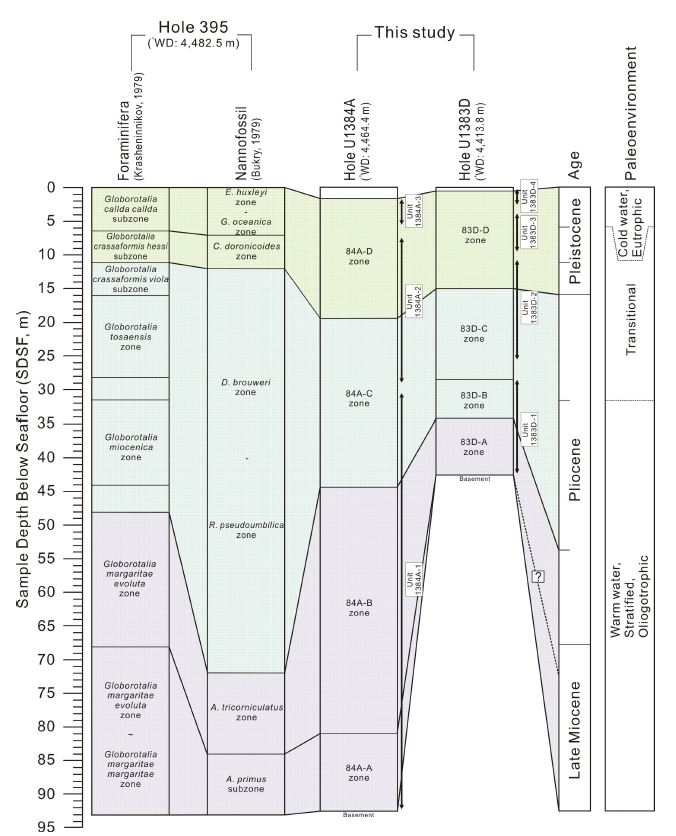
Biostratigraphic correlation of each hole in North Pond. The biostratigraphic units were recognized based on occurrence of three nannofossil groups and the results of grain size analysis. See Table 1 for detailed zonation scheme. *WD: Water depth.
이 연구에서 가장 오래된 지층은 Hole U1384A의 84A-A 분대에 속하고, Amaurolithus primus subzone/NN11B zone에 해당된다(그림 6; 표 1). 이 분대는 Hole 395의 초미화석에 의한 Amaurolithus primus subzone 및 유공충에 의한 Globorotalia margaritae margaritae zone과 대비되고 퇴적시기는 후기 마이오세이다(Bukry, 1979; Krasheninnikov, 1979). 그러나 Hole U1383D에서는 Amaurolithus primus subzone을 확인할 수 없었고, 이는 퇴적 당시 해저화산 분출에 의해 퇴적물이 쌓이지 않았기 때문이라고 추정되지만 더 자세한 연구가 필요하다(Melson et al., 1968; 그림 2).
Hole U1383D의 최하부(83D-A)와 Hole U1384A 기저퇴적층의 상부(84A-B)는 Amaurolithus tricorniculatus zone/NN12-NN14 zone에 해당된다(그림 6; 표 1). 이 분대는 Hole 395의 Amaurolithus tricorniculatus zone 및 Globorotalia margaritae evoluta zone과 대비되고 퇴적시기는 후기 마이오세 말-초기 플라이오세이다(Bukry, 1979; Krasheninnikov, 1979).
상부의 83D-B, 83D-C와 84A-C 분대는 Reticulofenestra pseudoumbilica zone/NN15-NN16 zone과 Discoaster brouweri zone/NN17-NN18 zone에 해당된다(그림 6; 표 1). 이 분대는 Hole 395의 Reticulofenestra pseudoumbilica zone, Discoaster brouweri zone 및 Globorotalia miocenica zone, Globorotalia tosaensis zone, Globorotalia crassaformis viola subzone과 대비되고 퇴적시기는 중기 플라이오세-후기 플라이오세이다(Bukry, 1979; Krasheninnikov, 1979).
최상부 지층의 83D-D와 84A-D 분대는 NN18 zone 이후부터 퇴적된 것으로 보인다(그림 6; 표 1). 이 분대는 Hole 395의 Crenalithus doronicoides zone, Gephyrocapsa oceanica zone과 Emiliania huxleyi zone 및 Globorotalia crassaformis hessi subzone, Globigerina callda callda subzone과 대비되고 퇴적시기는 플라이스토세이다.
5.3 고환경
석회질 초미화석은 일반적으로 해수의 온도를 유추하는데 사용되며, 최근 연구를 통하여 수온약층(thermocline), 영양염약층(nutricline) 및 용승작용(upwelling)과 같은 해양 표층환경의 영향을 강하게 받는 것으로 보고되었다(Driever, 1988; Farida et al., 2012). 석회질 초미화석 중 Discoaster는 하부 유광대(lower photic zone)에 서식하는 종이고 해양의 성층화 및 빈영양(oligotrophic) 환경을 지시한다(Farida et al., 2012). 또한 Discoaster는 저위도의 해양퇴적물에서 산출되는 것으로 알려져 있고, 열대-아열대 환경을 지시하는 종이다(Driever, 1988; Chepstow-Lusty et al., 1989; Rio et al., 1990; Dmitrenko, 2004). 특히 이 연구에서 가장 풍부하게 산출되었던 D. brouweri는 온난수괴의 영향하에서 생산력이 낮으며 영양분이 적은 환경을 지시하는 대표적인 종으로 온난수괴 및 빈영양 환경을 지시하는 종이다(Driever, 1988; Chapman and Chepstow-Lusty, 1997). 두 번째로 산출빈도가 높은 Ceratolithus는 Discoaster와는 달리 상부 유광대(upper photic zone)에 서식하는 종이다(Alcober and Jordan, 1997; Kameo, 2002). 이러한 특징을 바탕으로 퇴적 당시의 환경을 추론하면 다음과 같다.
Unit 1383D-1과 Unit 1384A-1은 후기 마이오세-중기 플라이오세의 퇴적층에 해당한다(그림 6). 이들은 모두 초미화석 산출빈도 및 입도의 변화가 거의 없는 특징을 보이기 때문에 동일한 환경에서 퇴적되었다고 판단된다(그림 3a-b). Unit 1383D-1과 Unit 1384A-1의 석회질 초미화석 중 우점종인 Discoaster는 모두 평균 이상의 산출빈도를 보이기 때문에 이들이 퇴적되었을 때 온난수괴의 영향이 우세하였던 것으로 보인다. 고기후 연구에 의하면, 연구지역은 플라이오세, 특히 중기 플라이오세(약 3 Ma)동안 현재 혹은 플라이스토세의 간빙기(130-75 ka)보다 더 따뜻한 기후였다고 보고되었다(Cronin, 1991; Dowsett et al., 1996). 온난한 기후는 해류에 의한 열운반(heat transport)의 영향을 받아 발생하며(Dowsett et al., 1996) 이는 난대 종(Discoaster)이 우점종이 될 수 있었던 근거가 된다. 따라서 연구지역은 후기 마이오세-중기 플라이오세 동안 온난수괴의 영향이 우세하였던 것으로 보이고, 이러한 해석은 기존의 연구자료와도 잘 일치한다. 또한 하부 유광대 종인 Discoaster가 풍부하다는 것은 수괴가 성층화되어 안정적이었다는 것을 의미한다(Kameo, 2002; Farida et al., 2012). 즉, 퇴적시기 동안 수온약층 및 영양염약층이 발달하였다는 것을 알 수 있고 빈영양 환경이었던 것으로 보인다.
Unit 1383D-2와 Unit 1384A-2는 후기 플라이오세-중기 플라이스토세의 퇴적층에 해당한다(그림 6). 이들은 초미화석 산출빈도 및 입도의 변화가 나타나기 시작하는 것으로 보아 같은 환경에서 퇴적되었다고 추정된다(그림 3a-b). 특히 Discoaster는 산출빈도의 변화 폭이 크고 Unit 1383D-1 및 Unit 1384A-1보다 평균 산출빈도가 감소하고 있다. 이는 퇴적시기 동안 연구지역의 해수 온도가 변화하기 시작해 점차 낮아졌음을 의미한다. 이러한 해석은 기존의 고기후 연구자료와도 잘 일치한다. 즉, 연구지역은 후기 플라이오세(약 2.5 Ma~)부터 기온의 한랭화(climatic cooling)가 진행되었다고 보고되었다(Cronin, 1991; Dowsett et al., 1996; Chapman and Chepstow-Lusty, 1997). 또한 Discoaster와 같은 하부 유광대 종의 감소는 표층수의 강한 혼합작용이 발생하여 수온약층 및 영양염약층이 약해졌다는 것을 의미한다(Okada and Wells, 1997; Chiyonobu et al., 2006). Ceratolithus는 온도에 대한 분명한 선호 양상이 없다고 하지만 이 종과 같이 상부 유광대에 서식하는 종은 주로 온도가 낮은 시기 동안 산출빈도가 높다고 보고되었다(Cohen, 1964; Henriksson, 2000). 따라서 이 구간에서 Ceratolithus의 산출빈도가 증가하였다는 것은 퇴적시기 동안 수온이 낮아졌다는 것을 뒷받침한다. 즉, 후기 플라이오세-중기 플라이스토세 동안은 온난수괴의 영향이 점차 약해지는 전이 환경이었던 것으로 해석된다.
Unit 1383D-3과 Unit 1384A-3은 후기 플라이스토세의 퇴적층에 해당한다(그림 6). 이 구간들은 Discoaster가 상당히 감소하여 평균 산출빈도보다 낮은 값을 보이는 반면 Ceratolithus는 점차 증가하여 평균 이상의 산출빈도를 보인다(그림 3a-b). 또한 Unit 1383D-4에서는 Discoaster의 산출빈도가 전 구간 중 가장 낮고, Ceratolithus는 최대 산출빈도를 보이며 두 종의 산출빈도 변화가 거의 없다. 이러한 특징은 Hole U1384A에서는 보이지 않으며 이는 교란에 의한 것이라 판단된다. 따라서 연구지역은 퇴적시기 동안 Discoaster와 같은 난대 종의 산출빈도가 급격히 감소한 후 변화하지 않는 것을 보아 온난수괴의 영향이 약해진 후 안정한 환경으로 변한 것으로 보인다. 중기 플라이스토세는 기후 전이대(climate transition)이고 후기 플라이스토세부터는 빙하기에 접어든다(Ruddiman et al., 1989; Mudelsee and Schulz, 1997). 즉, 수온이 급격하게 낮아졌음을 알 수 있고 이는 Discoaster의 산출빈도 양상과도 잘 일치한다. 상부 유광대 분류군인 Ceratolithus의 증가는 퇴적시기 동안 수온이 더욱 낮아진 것을 의미하고 상부와 하부의 수괴 차이가 거의 없어져 수온약층 및 영양염약층이 약해진 것으로 보인다. 또한 Discoaster의 매우 저조한 산출은 빈영양 환경에서 부영양(eutrophic) 환경으로 변하였음을 의미한다. 즉, North Pond 지역의 고환경은 후기 마이오세부터 플라이스토세까지 단계적인 변화를 거친 것으로 해석된다.
6. 결 론
North Pond의 두 개 시추 퇴적물(U1383D, U1384A)에서 산출된 석회질 초미화석을 이용하여 생층서 분대를 설정하고 고환경을 해석하였다. 석회질 초미화석 분석 결과, North Pond의 퇴적물은 신생대 신제3기-제4기의 석회질 초미화석으로 구성되어 있다. 그 중 특정 종들의 뚜렷한 산출빈도 변화에 따라 생층서 분대를 설정하고, 퇴적시기와 고환경을 추정하였다.
Hole U1383D에서는 3속 11종의 석회질 초미화석이 산출되었으며, 하부로부터 83D-A (Amaurolithus tricorniculatus zone/NN12-NN14, 후기 마이오세 말-초기 플라이오세), 83D-B (Reticulofenestra pseudoumbilica zone/NN15-NN16 zone, 초기 플라이오세-중기 플라이오세), 83D-C (Discoaster brouweri zone/NN17- NN18 zone, 후기 플라이오세), 83D-D (NN18 zone 이후, 플라이스토세)로 분대되었다. 즉, Hole U1383D 퇴적층은 NN12-NN18 zone과 대비되며 가장 오랜 퇴적시기는 약 5.6 Ma로 추정된다. Hole U1384A에서는 3속 13종의 석회질 초미화석이 산출되었으며, 하부로부터 84A-A (Amaurolithus primus subzone/NN11B zone, 후기 마이오세), 84A-B (Amaurolithus tricorniculatus zone/NN12-NN14, 후기 마이오세 말-초기 플라이오세), 84A-C (Reticulofenestra pseudoumbilica zone, Discoaster brouweri zone/NN15-NN18 zone, 초기 플라이오세-후기 플라이오세), 84A-D (NN18 zone 이후, 플라이스토세)에 대비된다. 즉, Hole U1384A 퇴적층은 NN11B-NN18 zone과 대비되며 가장 오랜 퇴적시기는 약 7.2 Ma로 추정된다.
연구지역은 후기 마이오세-중기 플라이오세 동안 Discoaster의 산출빈도가 매우 높은 것으로 보아 온난수괴의 영향이 우세하였고 수괴가 성층화된 빈영양 환경이었던 것으로 보인다. 후기 플라이오세-중기 플라이스토세 동안에는 Discoaster의 산출빈도가 변화하기 시작하여 점차 감소하지만 Ceratolithus는 증가하였기 때문에 온난수괴의 영향이 점차 약해지는 전이 환경이었던 것으로 해석된다. 후기 플라이스토세에는 최소 산출의 Discoaster와 최대 산출의 Ceratolithus를 통하여 수온이 매우 낮아진 것을 알 수 있으며 부영양 환경으로 변한 것으로 추정된다. 즉, North Pond 지역의 고환경은 후기 마이오세부터 플라이스토세까지 단계적인 변화를 거친 것으로 해석된다.
Acknowledgments
이 연구는 2014년 해양수산부 재원으로 한국해양과학기술진흥원의 지원을 받아 수행된 연구과제 “시추선 승선 및 후속연구(과제번호: 13-9102-2)”이다. 이 논문의 심사과정에서 많은 조언과 건설적인 비판을 통해 논문의 질적 향상에 많은 도움을 주신 충북대학교 이동찬 교수님, 전남대학교 고영구 교수님과 전북대학교 박영숙 박사님께 깊은 감사를 드린다.
References
-
J Alcober, R.W Jordan, An interesting association between Neosphaera coccolithomorpha and Ceratolithus cristatus (Haptophyta), European Journal of Phycology, (1997), 32, p91-93.
[https://doi.org/10.1017/S0967026296001047]

-
J Backman, N.J Shackleton, Quantitative biochronology of Pliocene and early Pleistocene calcareous nannofossils from the Atlantic, Indian and Pacific oceans, Marine Micropaleontology, (1983), 8, p141-170.
[https://doi.org/10.1016/0377-8398(83)90009-9]

-
S.J Blott, K Pye, GRADISTAT: A grain size distribution and statistics package for the analysis of unconsolidated sediments, Earth Surface Processes and Landforms, (2001), 26, p1237-1248.
[https://doi.org/10.1002/esp.261]

-
D Bukry, Biostratigraphy of Cenozoic marine sediment by calcareous nannofossils, Micropaleontology, (1978), 24, p44-60.
[https://doi.org/10.2307/1485419]

-
D Bukry, Neogene Coccolith Stratigraphy, Mid-Atlantic Ridge, Deep Sea Drilling Project, Leg 45, In: Melson, W.G., Rabinowitz, P.D. et al., 1979, Initial Reports of the Deep Sea Drilling Project, 45: Washington (U.S. Government Printing Office), (1979), p307-317.
[https://doi.org/10.2973/dsdp.proc.45.109.1979]

-
M.R Chapman, A.J Chepstow-Lusty, Late Pliocene climatic change and the global extinction of the discoasters: an independent assessment using oxygen isotope records, Palaeogeography, Palaeoclimatology, Palaeoecology, (1997), 134(14), p109-125.
[https://doi.org/10.1016/S0031-0182(97)00035-7]

-
A Chepstow-Lusty, J Backman, N.J Shackleton, Comparison of Upper Pliocene Discoaster abundance variations from North Atlantic Sites 552, 607, 658, 659 and 662: Further evidence for marine plankton responding to orbital forcing, In Ruddiman, W., Sarnthein M. et al., 1989, Proceedings of the Ocean Drilling Program, Scientific Results, (1989), 108, p121-141.
[https://doi.org/10.2973/odp.proc.sr.108.122.1989]

-
A Chepstow-Lusty, J.A.N Backman, N.J Shackleton, Palaeoclimatic control of Upper Pliocene Discoaster assemblages in the North Atlantic, Journal of Micropalaeontology, (1991), 9, p133-143.
[https://doi.org/10.1144/jm.9.2.133]

-
S Chiyonobu, T Sato, R Narikiyo, M Yamasaki, Floral changes in calcareous nannofossils and their paleoceanographic significance in the equatorial Pacific Ocean during the last 500,000 years, Island Arc, (2006), 15(4), p476-482.
[https://doi.org/10.1111/j.1440-1738.2006.00543.x]

-
C.L.D Cohen, Coccolithophorids from two Caribbean deep-sea cores, Micropaleontology, (1964), 10, p231-250.
[https://doi.org/10.2307/1484642]

-
T.M Cronin, Pliocene shallow water paleoceanography of the North Atlantic ocean based on marine ostracodes, Quaternary Science Reviews, (1991), 10, p175-188.
[https://doi.org/10.1016/0277-3791(91)90017-O]

- O.B Dmitrenko, Miocene nannofossil Paleoenvironment evidence in the Southern ocean biogeographic zonation, Environmental Micropaleontology, Microbiology and Meiobenthology, 2004, (2004), 1, p61-82.
-
H Dowsett, J Barron, R Poore, Middle Pliocene sea surface temperatures: a global reconstruction, Marine Micropaleontology, (1996), 27, p13-25.
[https://doi.org/10.1016/0377-8398(95)00050-X]

- B.W.M Driever, Calcareous nannofossil biostratigraphy and paleoenvironmental interpretation of the Mediterranean Pliocene, Utrecht Micropaleontological Bulletins, (1988), 36, p245.
-
K.J Edwards, W Bach, A Klaus, Mid-Atlantic Ridge flank microbiology: initiation of long-term coupled microbiological, geochemical, and hydrological experimentation within the seafloor at North Pond, western flank of the Mid-Atlantic Ridge, Science Prospectus of the Integrated Ocean Drilling Program, 336, Tokyo (Integrated Ocean Drilling Program Management International, Inc.), (2010).
[https://doi.org/10.2204/iodp.sp.336.101.2010]

-
Expedition 336 Scientists, Expedition 336 summary. In: Edwards, K.J., Bach, W., Klaus, A., and the Expedition 336 Scientists, Proceedings of the Integrated Ocean Drilling Program, 336, Tokyo (Integrated Ocean Drilling Program Management International, Inc.), (2012a).
[https://doi.org/10.2204/iodp.proc.336.101.2012]

-
Expedition 336 Scientists, Sediment and basement contact coring. In Edwards, K.J., Bach, W., Klaus, A. and the Expedition 336 Scientists, Proceedings of the Integrated Ocean Drilling Program, 336, Tokyo (Integrated Ocean Drilling Program Management International, Inc.), (2012b).
[https://doi.org/10.2204/iodp.proc.336.106.2012]

-
M Farida, R Imai, T Sato, Miocene to Pliocene Paleoceanography of the Western Equatorial Pacific Ocean Based on Calcareous Nannofossils, ODP Hole 805B, Open Journal of Geology, (2012), 2(2), p72-79.
[https://doi.org/10.4236/ojg.2012.22008]

- T.G Ferdelman, A Picard, M Morando, W Ziebis, Direct Experimental Assessment of Microbial Activity in North Pond Sediments, American Geophysical Union, Fall Meeting 2009 (Abstract) #B23C-0386, (2009).
- R.L Folk, W.C Ward, Brazos River bar [Texas]; A study in the significance of grain size parameters, Journal of Sedimentary Research, (1957), 27, p3-26.
-
A.S Henriksson, Coccolithophore response to oceanographic changes in the equatorial Atlantic during the last 200,000 years, Palaeogeography, Palaeoclimatology, Palaeoecology, (2000), 156, p161-173.
[https://doi.org/10.1016/S0031-0182(99)00139-X]

-
D.M Hussong, P.B Fryer, J.D Tuthill, L.K Wipperman, The Geological and Geophysical Setting near DSDP Site 395, North Atlantic Ocean, In: Melson, W.G., Rabinowitz, P.D. et al., 1979, Initial Reports of the Deep Sea Drilling Project, 45: Washington (U.S. Government Printing Office), (1979), p23-37.
[https://doi.org/10.2973/dsdp.proc.45.102.1979]

-
K Kameo, Late Pliocene Caribbean surface water dynamics and climatic changes based on calcareous nannofossil records, Palaeogeography, Palaeoclimatology, Palaeoecology, (2002), 179, p211-226.
[https://doi.org/10.1016/S0031-0182(01)00432-1]

-
V.A Krasheninnikov, Stratigraphy, by Means of Planktonic Foraminifers, of Neogene and Quaternary Sediments near the Crest of the Mid-Atlantic Ridge, DSDP Sites 395 and 396, In: Melson, W.G., Rabinowitz, P.D. et al., 1979, Initial Reports of the Deep Sea Drilling Project, 45: Washington (U.S. Government Printing Office), (1979), p319-322.
[https://doi.org/10.2973/dsdp.proc.45.110.1979]

- P.H Kuenen, H.W Menard, Turbidity currents, graded and non-graded deposits, Journal of Sedimentary Research, (1952), 22, p83-96.
-
M Marino, J.A Flores, Miocene to Pliocene calcareous nannofossil biostratigraphy at ODP Leg 177 Sites 1088 and 1090, Marine Micropaleontology, (2002), 45, p291-307.
[https://doi.org/10.1016/S0377-8398(02)00033-6]

- E Martini, Standard Tertiary and Quaternary calcareous nannoplankton zonation, Proceedings of the Second Planktonic Conference, Roma 1970, (1971), p739-785.
- W.G Melson, G Thompson, T.H van Andel, Volcanism and metamorphism in the Mid-Atlantic Ridge, 22°N latitude, Journal of Geophysical Research, (1968), 73, p5925-5941.
-
W.G Melson, P.D Rabinowitz, J.H Natland, H Bougault, H.P Johnson, Cruise Objectives and Major Results, Analytical Procedures, and Explanatory Notes, In: Melson, W.G., Rabinowitz, P.D. et al., 1979, Initial Reports of the Deep Sea Drilling Project, 45: Washington (U.S. Government Printing Office), (1979), p131-264.
[https://doi.org/10.2973/dsdp.proc.45.101.1979]

-
M Mudelsee, M Schulz, The Mid-Pleistocene climate transition: onset of 100 ka cycle lags ice volume build-up by 280 ka, Earth and Planetary Science Letters, (1997), 151, p117-123.
[https://doi.org/10.1016/S0012-821X(97)00114-3]

-
H Okada, P Wells, Late Quaternary nannofossil indicators of climate change in two deep-sea cores associated with the Leeuwin Current off Western Australia, Palaeogeography, Palaeoclimatology, Palaeoecology, (1997), 131, p413-432.
[https://doi.org/10.1016/S0031-0182(97)00014-X]

-
A Picard, T.G Ferdelman, Linking microbial heterotrophic activity and sediment lithology in oxic, oligotrophic sub-seafloor sediments of the north atlantic ocean, Frontiers in Microbiology, (2011), 2, p263.
[https://doi.org/10.3389/fmicb.2011.00263]

-
O.H Pilkey, The size distribution and mineralogy of the carbonate fraction of United States South Atlantic shelf and upper slope sediments, Marine Geology, (1964), 2, p121-136.
[https://doi.org/10.1016/0025-3227(64)90030-1]

-
G.M Purdy, P.D Rabinowitz, H Schouten, The Mid-Atlantic Ridge at 23°N: Bathymetry and Magnetics, In: Melson, W.G., Rabinowitz, P.D. et al., 1979, Initial Reports of the Deep Sea Drilling Project, 45: Washington(U.S. Government Printing Office), (1979), p119-128.
[https://doi.org/10.2973/dsdp.proc.45.106.1979]

-
D Rio, I Raffi, G Villa, Pliocene-Pleistocene calcareous nannofossil distribution patterns in the western Mediterranean, In Kastens, K.A., Mascle, J. et al., 1990, Proceedings of the Ocean Drilling Program, Scientific Results, (1990), 107, p513-533.
[https://doi.org/10.2973/odp.proc.sr.107.164.1990]

-
W.F Ruddiman, M.E Raymo, D.G Martinson, B.M Clement, J Backman, Pleistocene evolution: Northern Hemisphere ice sheets and North Atlantic Ocean, Paleoceanography, (1989), 4, p353-412.
[https://doi.org/10.1029/PA004i004p00353]

-
F Schmidt-Schierhorn, N Kaul, S Stephan, H Villinger, Geophysical site survey results from North Pond(Mid-Atlantic Ridge), In Edwards, K.J., Bach, W., Klaus, A. and the Expedition 336 Scientists, Proceedings of the Integrated Ocean Drilling Program, 336, Tokyo (Integrated Ocean Drilling Program Management International, Inc.), (2012).
[https://doi.org/10.2204/iodp.proc.336.107.2012]

-
Shipboard Scientific Party, Site 395: 23°N, Mid-Atlantic Ridge. In: Melson, W.G., Rabinowitz, P.D. et al., 1979, Initial Reports of the Deep Sea Drilling Project, 45: Washington (U.S. Government Printing Office), (1979), p131-264.
[https://doi.org/10.2973/dsdp.proc.45.107.1979]

- E.D Stefano, Calcareous nannofossil quantitative biostratigraphy of Holes 969E and 963B (Eastern Mediterranean), In Rovertson, A.H.F., Emeis, K.C., Richter, C. and Camerlenghi, A., (eds.), 1998, Proceedings of the Ocean Program, Scientific Results, (1998), 160, p99-112.
-
P.P Timofeev, I.M Varentsov, M.A Rateev, N.V Renngarten, Lithology, Mineralogy, and Geochemistry of Upper Cenozoic Sediments at 23˚N near the Mid-Atlantic Ridge, Drilled on Leg 45, In: Melson, W.G., Rabinowitz, P.D. et al., 1979, Initial Reports of the Deep Sea Drilling Project, 45: Washington (U.S. Government Printing Office), (1979), p323-347.
[https://doi.org/10.2973/dsdp.proc.45.112.1979]

- T.H van Andel, P.D Komar, Ponded Sediments of the Mid-Atlantic Ridge between 22˚ and 23˚ North Latitude, Geological Society of America Bulletin, (1969), 80(7), p1163-1190.
- J.R Young, Calcareous nannofossil biostratigraphy, In: Bown, P.R. (eds.), British Micropaleontology Society Series, Chapman & Hall, London, (1999), p226-266.
